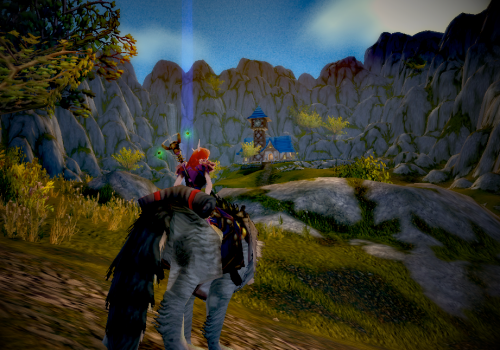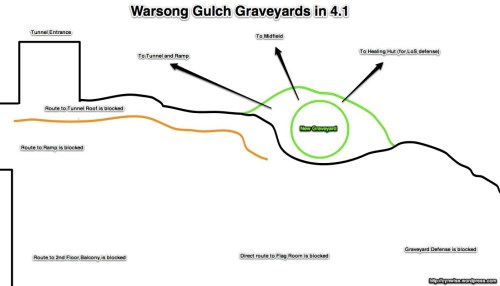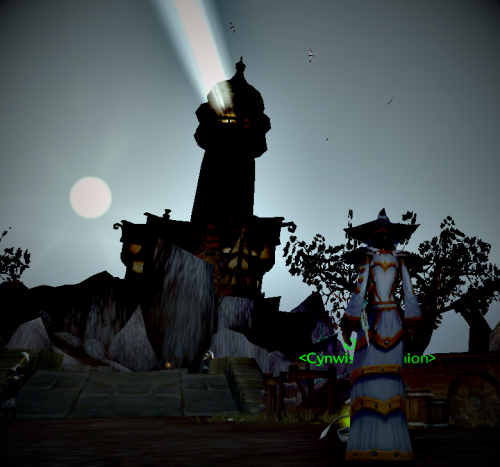Patch 4.1 is going to bring some substantial changes to battlegrounds. The patch notes are up in a relatively final format, so I finally feel comfortable talking about them.
Let’s take a look.
HONOR GAINS DOUBLED
The rate at which Honor Points are earned has been doubled.
Thank goodness for this change. When the new system debuted at in 4.0.1, we assumed that the reason Honor was so hard to grind was because we weren’t at 85. Once we hit 85, it became clear that no, it just took a lot of time to get gear.
Then Tol Barad happened, and … well… let’s just say that if you got gear during that week, your grind was short, and if not, it was long. It felt about as tough as the grind in mid-Wrath, before Blizzard adjusted it to take as much time as gearing up for Heroics.
This will be good for PvPers gearing up. It may have unintended side effects when combined with the new Justice Point conversions, however. We’ll have to see how it works.
Speaking of conversions…
PvP AND PvE POINT CONVERSIONS
Conquest Points are now purchasable from the Valor Quartermasters at 250 Conquest Points per 250 Valor Points.
Honor Points are now purchasable from the Justice Trade Goods vendors at 250 Honor Points per 375 Justice Points.
Justice Points are now purchasable from the Honor Trade Goods vendors at 250 Justice Points per 375 Honor Points.
I’ve written about this change at some length before. Good? Bad? Tough to say until we see how the Honor and Justice gains pan out; my guess is that regular Battlegrounds will be a great way to get DPS into Justice Gear.
FOCUSED/BRUTAL ASSAULT
This change is aimed at Flag Carriers in WSG and Twin Peaks, and is going to make their jobs more difficult with the aim of shortening games.
After 3 minutes of both teams having the flag, both flag carriers will get Focused Assault, which increases damage taken by 10%.
Every minute afterward, an additional stack will be applied to increase damage taken by an additional 10%.
After 7 minutes, Brutal Assault will be applied in place of Focused Assault. In additional to the damage debuff, this debuff also caps the player’s movement speed at 100%. The damage taken debuff works the same and will add 10% to the debuff up to a maximum of 100% damage taken.
My take on this is that it is directed entirely at rated battleground matches, in an attempt to make the matches move faster. A good FC/2-healer team can keep themselves alive for some time, which prolongs the match. Most of the changes we’ll see to battlegrounds have this theme – make it easier to attack, harder to defend. This will have interesting implications in all brackets.
It also is a direct blow to Druid FCs, as their speed in Travel Form helps them be superior flag carriers compared to other classes. Damage Avoidance will now be key, so expect to see Blood DKs and Prot Warriors as FCs even more often.
10 v 10 ARATHI BASIN
Arathi Basin is now available as a 10v10-player rated Battleground.
While this is going to be weird, it’s necessary to add some variety to rated play. Right now there are two CTF maps and one Resource map; this adds in a second Resource map. With the loss of the 15s, there needs to be more variety in Rated Battlegrounds, and this helps quickly add AB back into play.
FASTER FLAG CAPS IN AB/BfG
Flags should now cap in 7 seconds, down from 8.
This is another rated change. By taking a second off of the cap timer, bases should flip a little more often, which would invoke new graveyard conditions and resurrection vectors, making for a more dynamic game.
GRAVEYARD CHANGES: BATTLE FOR GILNEAS
Players who die at a control point that they own will now be teleported to the next closest graveyard, instead of the one at which they died.
If a player’s team owns the Mine and Waterworks, and dies at Waterworks, they will be teleported to the Mine.
If an Alliance player’s team only owns Lighthouse, and dies at Lighthouse, they will respawn at their base.
If a Horde player’s team owns Waterworks and Mine, and dies at Lighthouse, they will respawn at Waterworks.
The simple summary is: you will always be sent away from the base you die at, no matter if you control it.
This is a substantial change to make this battleground more dynamic, designed to make node defense more difficult by sending the defenders away from the node (just like the attackers), allowing a larger attacking force to actually overwhelm a node, instead of having the resurrection wave of the defenders keep them up.
Look at the example they used above:
This is a departure from the Arathi Basin paradigm, where you resurrect near the node you are defending. Attackers will still need to fight at the flag, but defenders will need to coordinate reinforcements between nodes. Instead of stationary teams, you’ll have to constantly replenish each base’s forces.
In some ways, this is an anti-healer change. Stationing a dedicated healer at each node in the current design allows a defending force to keep the base. This change will send the healer away from the base, allowing the attackers more time to kill the defending DPS. Right now killing a healer only gives them a window of about 15-45 seconds to burn as many people down as they can, and that’s not much of a window.
I have a few questions about how the resurrection vectors will work in certain cases (what if Alliance controls Mine but not LH or WW, for instance? Do they go back to the spawn point?) but will have to see how this shakes out.
Keep in mind non-rated play will be affected, just like rated matches, so coordination of team strength in a PuG will be key to success.
GRAVEYARD CHANGES: TWIN PEAKS
More changes to the graveyards and resurrection vectors, courtesy of rated battlegrounds:
Players will now only spawn at their base graveyard when they die in the enemy base.
Defending players will respawn at the middle graveyard.
Midfield players will respawn at the middle graveyard.
Attacking players will respawn at their base graveyard.
This is an interesting change.
First, it’s interesting because it reminds me that I still haven’t finished my guide to Twin Peaks, but I’m seriously lacking the motivation to do WSG 2.0 when WSG 1.0 is still so interesting!
Also, it’s interesting because it’s very deliberately making it harder to defend your base and the FC. No longer do defenders go back to the base graveyard, instead they move up to midfield. Balancing that change, however, is a huge penalty to attackers – getting sent entirely across the map, instead of rezzing at midfield.
Here’s a quick and dirty diagram of how it will work:
 There are two problems these changes are trying to solve.
There are two problems these changes are trying to solve.
- Defenders, and by defenders I mean defending healers, currently can get back into the base, and back to the FC, very quickly. This change will make it easier to take down the FC.
- Sending attackers back to midfield was an insufficient penalty, allowing a team that focused heavily on offense to weight the field towards the enemy base, causing a turtle. (Defenders would rez by base, offense maintains pressure to keep them there.) This change makes the field more dynamic.
Frankly, this is going to mean more fights in midfield, which given some of the TP turtles I’ve seen, might not be a bad thing. This fits in very strongly with the anti-defense theme we’re seeing in this patch, which might make rated battlegrounds more exciting – but it also might be like introducing nets to football.
One item of note – I don’t see anything about fixes to the Leap of Faith exploit some people have reported in Twin Peaks. (Priest dies, rezzes, pulls FC up to GY, FC can’t be killed.) Hopefully that will be addressed in this patch, too.
GRAVEYARD CHANGES: WARSONG GULCH
This is the graveyard change that will have the greatest impact on players, as WSG is available at level 10, while Twin Peaks and Battle For Gilneas only open up at 85.
The graveyards outside both bases have been lowered in elevation and are no longer on the same plane as the main flag room entrances to either respective base.
When this change was originally announced, there was uproar because of the context in which it was presented – as an anti-camping change. It’s not. If anything, it will make graveyard camping easier, not harder.
No, this is purely a change for rated battleground play, and it’s the first change where rated play is going to dramatically impact non-rated play, including leveling characters. Let’s take a look.
This is how the Warsong Gulch graveyard currently operates.
The GY is on the same level as the main structure, which allows for numerous vectors when characters resurrect. They can rush to the flag room to assist with defense (about 15 seconds), they can assist with graveyard defense (immediate), they can go to the balcony (about 18 seconds), or they can leap down to midfield.
The proposed changes moves the GY down onto its own level, like so:
This change eliminates a number of options from the GY, most notably going directly back to the flag room. Resurrecting characters will be unable to get back into the base without going down to midfield and then running around to the tunnel or ramp entrances.
I hate to say it, but this change is really targeted at healers in rated battlegrounds. Rated BGs should have 2-3 healers, and with the current layout, healers are only out of a FR defense for about 30-45 seconds. This change is to open the window of opportunity for the attackers to take down the FC once the healers are gone.
As for ganking? Well, this change actually makes it easier to camp the enemy graveyard, especially with multiple healers:
Place your ranged up top, your melee down below, and your healers out of range of the GY. Once in position, your healers are essentially untouchable, and your DPS can grind the opposing team until they give up. Contrast that with the current layout, where you can directly engage your attackers if they are on the same level, or retreat out of range of ranged attackers firing through the hill below you.
Don’t believe the hype. This change is not about graveyard camping.
This is the first change made for Rated PvP where I think it’s going to have a negative effect upon the non-rated battlegrounds, especially leveling battlegrounds. It takes away the strategic depth of the Graveyard and limits player choices to essentially two routes – back up the tunnel, or out into midfield on offense. The lowest, non-mounted brackets will find this a real challenge to get back to the flag room, which can often mean the difference between a cap and no cap when everyone runs at the same speed (except Druids and Shamans.)
I’m not saying this change shouldn’t be made; I don’t play enough rated battlegrounds to know if they’re too defensive right now or not.
But this is going to have impacts on lowbie PvP that might – and I stress might – make WSG a lot less fun to play. We’ll have to see.
RESILIENCE SCALING CHANGES
Resilience scaling has been modified for linear returns, as opposed to increasing returns. Under the new formula, going from 30 resilience to 40 resilience gives players the same increase to survivability as going from 0 to 10. Resilience now scales in the same way armor and magic resistances do. A player with 32.5% damage reduction from resilience in 4.0.6 should see their damage reduction unchanged in 4.1. Those with less than 32.5% will gain slightly. Those with more will lose some damage reduction, increasingly so as their resilience climbs.
I’ve posted on this before, as well – the stat will change so that the effect of the stat becomes linear, instead of the stat. Oh, just go read the post. 🙂
Overall this is a positive change. This will improve the survivability of people with lower Resilience ratings. That first piece of PvP gear should feel like it matters. Improving survivability early on while gearing will be a very good thing.
The higher levels of Resilience will be less effective, though, but again – that’s probably a good thing. Too much Resilience can go to your head.
UNDOCUMENTED ENCHANTMENT CHANGES
These aren’t from the patch release notes, but rather a compilation of changes discovered on the PTR at TwinkInfo. To sum up:
- BC enchants which require an item level of 35 will now also require a character level of 25. (This removes the +15 Resilience, +6 Stats and +150 Health enchants from the 10-24 brackets.)
- Several items, like the Haliscan Jacket, have had their item levels lowered, so they can’t take BC enchants anymore.
- Wrath enchants will now require a minimum level of 50. This impacts the 49 bracket significantly.
- Netherweave bandages and higher will have level requirements.
- MP5 enchants have been converted into Spirit enchants.
- HP5 enchants have been converted into Stamina enchants.
Most of these changes will actually make it a little easier to make a new twink, removing the effectiveness of some of the grandfathered items. While I’m a little disappointed I can’t bust out my Inferno Robe with +150 Health on Cynderblock anymore, I’ll get over it.
(Thanks to Psynister for the tip on this one.)
OTHER CHANGES
There are a host of achievement changes in 4.1, mostly tuning and bugfixes. PvP trinkets and Every Man For Himself will get a new spell effect, Escape Artist is no longer sharing a cooldown.
But the changes above are substantial enough. The smaller battlegrounds are starting to feel the effects of rated play, and we may see more changes coming to other old favorites soon because of it. This is new territory for battlegrounds, which means it’s a little scary and exciting all mixed together.
Let’s see how it all works out.










